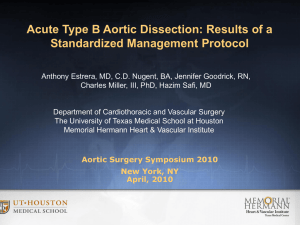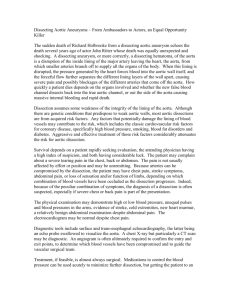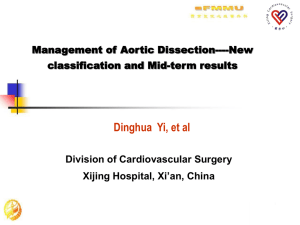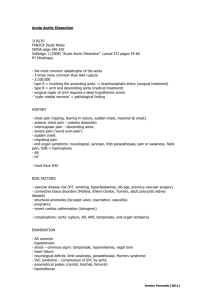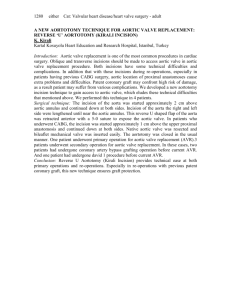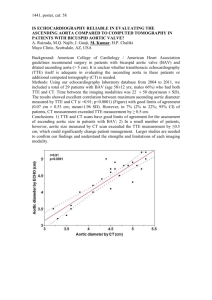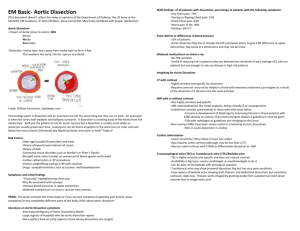Aortic Dissection - Adrian Manapat,MD
advertisement
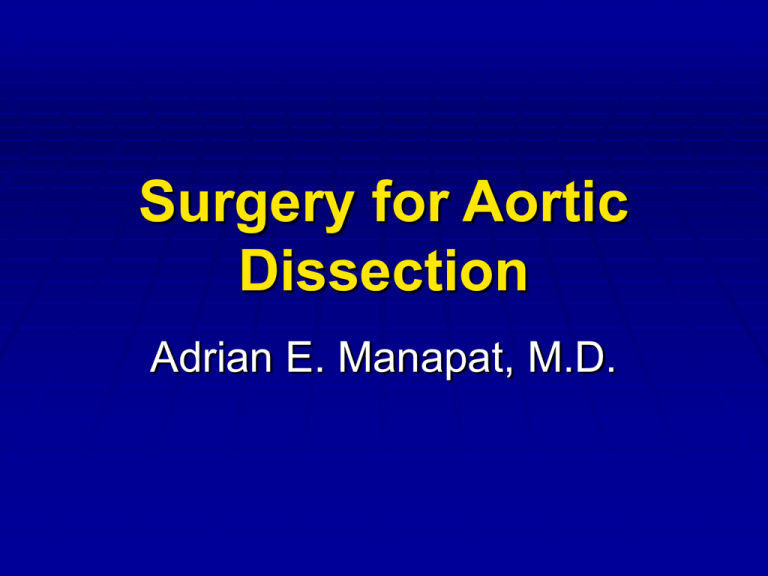
Surgery for Aortic Dissection Adrian E. Manapat, M.D. Mortality of Aortic Dissection Acute aortic dissection Lindsay, Hurst (1967) : 33% within 24 hrs 50% within 48 hrs 80% within 7 days 95% within 1 month for Type B 25% at 1 month Acute/Chronic/A/B Anagnostopoulos (1972) 70% at 1 week 90% at 3 months Management of acute aortic dissection Type A dissection Surgical repair (Modes of exit: Cardiac tamponade MI Heart failure from AI Stroke) Type B dissection Medical > Surgical Risk of cardiac tamponade 2% Stanford Duke Collaborative Study 80 70 60 50 40 Medical Surgical 30 20 10 0 Life Other medical Low risk, open threatening problems choice complications Management of Type B dissection Indications for surgery 1. Life threatening complications of dissection a) Aortic rupture/leak b) Infarction/ischemia of major end organ (kidneys, abdominal viscera, extremities) 2) Progression of dissection during medical treatment Indications for medical management 1) Elderly 2) Coexisting serious medical problem - cardiac, pulmonary, renal , peripheral or cerebrovascular 3) Thrombosed false lumen 4) Primary tear in distal aorta or abdominal aorta Craig Miller, 1992 Principles of repair Complete obliteration of the tear of the ascending aorta Obliteration of the false lumen Prevention of rupture of the jeopardized segment Correction of aortic regurgitation if present What is so difficult about repair of aortic dissection? Weakened friable aorta does not tolerate clamping - requires “no touch technique” Need for deep hypothermic circulatory arrest Prolonged complex operation Almost all of them bleed Potential for multiple organ damage Possible catastrophic complications Emergency nature Deep hypothermic circulatory arrest (DHCA) Every 10 o decrease in T causes a 50% decrease in metabolic rate - protects the organs from the effects of circulatory arrest Safe period CA is usually 45 minutes Disadvantages: prolonged surgery bleeding potential for end organ damage Cerebral protection during circulatory arrest Cerebral perfusion Antegrade perfusion via carotid arteries Retrograde perfusion via superior vena cava Adjunctive measures: Head packed in ice Mannitol, steroids Sodium pentothal Trendelenberg position Surgical options Supracoronary AA replacement Bentall procedure (composite ascending aorta & aortic valve replacement w/ re-implantation of coronary ostia) Supracoronary AA replacemnt w/ aortic valve repair or replacement Any of the above combined with CABG Ascending aortic dissection False and true lumen Dealing with the aortic valve Resuspension of the commissures to repair the aortic valve Insertion of a valved conduit Proximal graft anastomosis completed Aortic graft in place Ascending aortic replacement with CABG Results of Surgical repair Operative (30-day) mortality 1960’s 30-60% 1990’s to the present 5-30% Cleveland Clinic experience (208) predictors of mortality: Earlier operative year Hypotension Non-use of DHCA Composite valve graft CABG Late survival (Crawford, 1990) 1 year 78% 5 years 63% 10 years 55% Acute type A 5 yrs 56% 10 yrs 46% 20 yrs 30% Long term follow up Lifelong antihypertensive, B blocker Anticoagulation for prosthetic valve Surveillance : new dissections aneurysm formation prosthetic valve function




